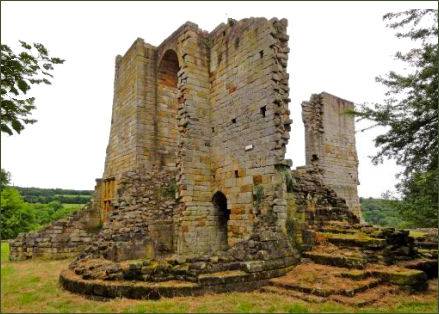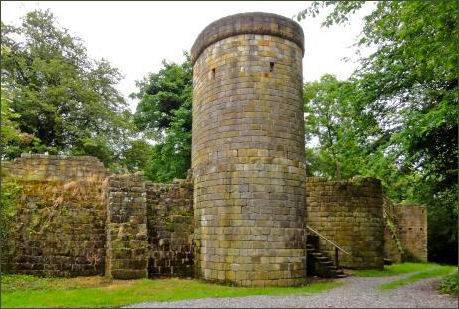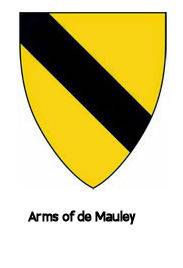Mulgrave Castle
OS grid reference:- NZ 839 116
 Mulgrave Castle consists of three structures on the Mulgrave Estate at Lythe, near Whitby. Legend relates that the oldest of these, referred to as the "ancient" castle, was founded by Wada, a sixth century ruler of Hälsingland. The second castle, caput of the feudal barony of Mulgrave, dates to the Norman era. The third is a country house built by Lady Catherine Darnley.
Mulgrave Castle consists of three structures on the Mulgrave Estate at Lythe, near Whitby. Legend relates that the oldest of these, referred to as the "ancient" castle, was founded by Wada, a sixth century ruler of Hälsingland. The second castle, caput of the feudal barony of Mulgrave, dates to the Norman era. The third is a country house built by Lady Catherine Darnley.
The Norman castle, originally known as Foss Castle, is said to have been built by one Nigel Fossard (died about 1120), who acquired the property following the Norman Conquest. Fossard is recorded in the Domesday Book of 1086 as a tenant of 114 manors, all in Yorkshire, including under Robert, Count of Mortain, half-brother of Willam the Conqueror. Fossard himself a tenant-in-chief of King William in 1088, and a holder of the large feudal barony whose caput was at Mulgrave, which was hence known as the barony of Mulgrave.
The castle remains consist of the curtain wall plus portions of several towers. The main approach to the castle was situated on the west side, with two stone towers overlooking the entrance. Differing levels of land surrounding the containing walls caused the wall to bulge outwards, which required buttressing. Some of the bricks used in the structure are clearly Roman.
Nigel Fossard's son Robert died circa 1135, Robert's was succeeded by his son William. The family continued to rise in prominence throughout the twelfth century. William Fossard was present at the Battle of the Standard in 1138 and helped defeat King David of Scotland who was seeking to exploit the turbulence in England caused by the Civil War between the cousins King Stephen and Queen Matilda, both grandchildren of William 'the Conqueror'. William Fossard died around 1170, leaving a son William II, who died in 1195 who himself left an heiress Joan, who married Robert de Turnham, who had served Richard the Lionheart during the Third Crusade, having seen action during the conquest of Cyprus. Their only surviving child and heiress was Isabel de Turnham who brought the barony and castle to Peter de Mauley (d.1241) to whom she had been granted in marriage by King John. De Mauley was a native of Poitou, whose marriage to this wealthy heiress is said to have been his reward for having murdered Arthur of Brittany in 1203, the teenage Arthur was the son of John's elder brother Geoffrey, Duke of Brittany, who threatened his succession to the English throne. He was governor of Corfe Castle in Dorset where he acted as jailer of Eleanor, Arthur's sister.
Peter I's heir was Peter II de Mauley (1226–1279), who married Joan de Brus (d.1243), one of five sisters of Peter III de Brus (d.1272), feudal baron of Skelton in Yorkshire, who was his brother-in-law, having married Hilary de Mauley, Peter II's sister. In the time of Peter II the barony was held by knight service of supplying two knights in time of war in the king's presence for 40 days per annum. Peter II's heir was Peter III de Mauley (d.1308), who married Nicole de Ghent (d. before 1302), sister and in her issue co-heir (in a 1/3rd share) to Gilbert V de Ghent (d.1298), feudal baron of Folkingham, Lincolnshire. Peter III was summoned to parliament by writ dated 23 June 1296, creating him the 1st Baron de Mauley. Peter III's seal can be seen as one of 72 appended to the Barons' Letter, 1301 to the Pope, sealed at the Parliament of Lincoln in January 1301.

 He was succeeded by Peter IV de Mauley (d.1348).
The castle later passed to Sir John Bigot (c.1376-1426/7) of Settrington, on his marriage to Constance de Mauley (c.1385-15/12/1450), eldest daughter & co-heiress of Peter VII de Mauley (d.1378), whose son Peter VIII had died in 1415 without issue, when the Barony de Mauley by writ became extinct. Bigot was 5th in descent from Hugh Bigod, 3rd Earl of Norfolk (d.1225).
He was succeeded by Peter IV de Mauley (d.1348).
The castle later passed to Sir John Bigot (c.1376-1426/7) of Settrington, on his marriage to Constance de Mauley (c.1385-15/12/1450), eldest daughter & co-heiress of Peter VII de Mauley (d.1378), whose son Peter VIII had died in 1415 without issue, when the Barony de Mauley by writ became extinct. Bigot was 5th in descent from Hugh Bigod, 3rd Earl of Norfolk (d.1225).
The property passed to the Radcliffes on the marriage of Dorothy Bigot into that family, before settling in 1625 on Lord Sheffield of Butterwick, Lord of Lieutenant of Yorkshire for both James I and Charles I and later to be titled Earl of Mulgrave by Charles I. There is evidence that the initial construction by the Fossards was updated and altered by subsequent residents.
The castle was garrisoned by royalists during the Civil War. Subsequently, it was dismantled by Parliamentary order in 1647; the lie of bricks from the destruction suggest that gunpowder might have been employed for this purpose.
The castellated mansion was built by Lady Catherine Darnley, Duchess of Buckingham, illegitimate daughter of James II and then the wife of John Sheffield, 1st Duke of Buckingham and Normanby. The property passed to the Phipps family in 1718, when the Duchess's daughter Lady Catherine Annesley married William Phipps. A summer house was also built on the grounds, according to legend on the spot of a hermitage which William de Percy established in 1150.
Public access is allowed subject to a number of conditions.
